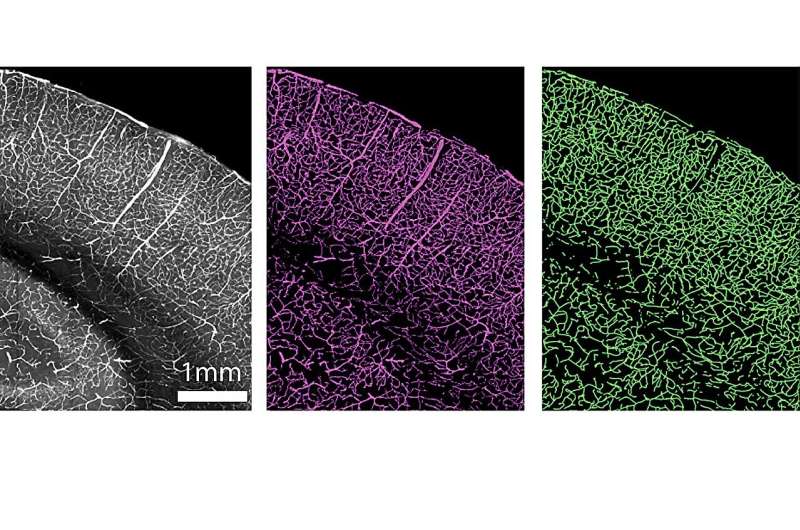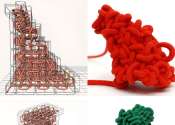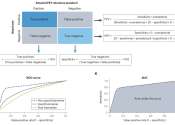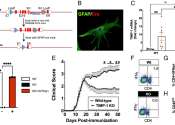JULY 30, 202
New high-resolution 3D maps show how the brain's blood vessels change with age

Healthy blood vessels matter for more than just heart health. Vascular well-being is critical for brain health and potentially in addressing age-related cognitive decline and neurodegenerative disorders, like Alzheimer's disease, according to a new study led by Penn State researchers.
The study is published in the journal Nature Communications.
"With something like Alzheimer's disease, by the time you can see vascular changes and significant brain shrinkage on a MRI, cell death has already occurred. We need to understand how these cells and structures change before a major catastrophe happens," said Yongsoo Kim, associate professor of neural and behavioral sciences at Penn State College of Medicine and senior author of the study.
According to Kim, aging is one of the primary factors involved in neurodegenerative disorders.
"Yet, we really don't have a good baseline understanding of how normal aging itself changes the brain, particularly the brain's vasculature," Kim said.
- And with the aging population in the United States growing, he said it's critical to understand these changes, especially within the network of blood vessels.
Kim and the research team produced a detailed map of the vascular network of the whole mouse brain using two high-resolution 3D mapping techniques: serial two-photon tomography—a technique that creates a series of stacked 2D images—and light sheet fluorescence microscopy, which images intact 3D samples to visualize the whole brain at a single cell-resolution. They imaged the brains of young and old mice to chart vasculature changes across the brain with normal aging.
"Because we're doing high-resolution mapping with sufficient resolution, we can reconstruct the whole vascular structure and scan the entire brain to pinpoint areas that undergo selective degeneration with age," Kim said.
- The images showed that changes in the vascular network don't occur equally across the brain.
- Rather, they were concentrated in the basal forebrain, deep cortical layers and hippocampal network, suggesting these areas are more vulnerable to vascular degeneration.
- These regions play a role in attention, sleep, memory processing and storage, among other functions.
The team also examined functional changes of vasculature and found that the system responds more slowly in older brains.
- That means that it can't provide the neurons with energy as quickly and readily as the cells may need.
- There's also a loss of pericytes, a type of cell that regulates blood supply and blood vessel permeability, too.
- As a result, the blood vessels become "leaky," compromising the blood-brain barrier.
- Hannah Bennett, dual medical degree and doctoral degree student, and Steffy Manjila, postdoctoral scholar, co-led the study along with Quingguang Zhang, who was assistant research professor at Penn State at the time of the research and is currently assistant professor at Michigan State University, and Yuan-ting Wu, who was previously research scientist at Penn State and currently project scientist at Cedars-Sinai Medical Center.
- Other Penn State authors on the paper include Patrick Drew, professor of engineering science and mechanics, of neurosurgery, of biology and of biomedical engineering and interim director of the Huck Institutes of the Life Sciences; Uree Chon, research technician; Donghui Shin, research technologist; Daniel Vanselow, research project manager; Hyun-Jae Pi, data scientist.
More information: Hannah C. Bennett et al, Aging drives cerebrovascular network remodeling and functional changes in the mouse brain, Nature Communications (2024). DOI: 10.1038/s41467-024-50559-8

Researchers introduce knitted furniture
Yuichi Hirose has a dream—a dream that someday everyone will have access to a machine capable of knitting furniture.
ROBOTICS
3 HOURS AGO

Researchers to present new tool for enhancing AI transparency and accuracy at conference
While large language models (LLMs) have demonstrated remarkable capabilities in extracting data and generating connected responses, there are real questions about how these artificial intelligence (AI) models reach their ...
MACHINE LEARNING & AI
3 HOURS AGO

Accuracy of diagnostic blood tests for Alzheimer's disease varies
Neurologists diagnose cognitive impairment with a clinical exam of memory and thinking skills. To determine whether Alzheimer's disease is the cause of the cognitive impairment, evidence of the specific brain changes that ...
ALZHEIMER'S DISEASE & DEMENTIA
3 HOURS AGO

Chronic cough may be hereditary, according to two new studies
Chronic cough is among the most common reasons for seeking medical care, with middle-aged women the group most affected. New studies at Uppsala University also show that this condition appears to be a hereditary phenomenon. ...
DISEASES, CONDITIONS, SYNDROMES
3 HOURS AGO

Breaking MAD: Generative AI could break the internet
Generative artificial intelligence (AI) models like OpenAI's GPT-4o or Stability AI's Stable Diffusion are surprisingly capable at creating new text, code, images and videos. Training them, however, requires such vast amounts ...
COMPUTER SCIENCES
3 HOURS AGO

Genes or environment? A new model for understanding disease risk factors
Every disease is shaped by a genetic component as well as environmental factors like air pollution, climate and socioeconomic status. However, the extent to which genetics or environment play a role in disease risk—and ...
HEALTH INFORMATICS
3 HOURS AGO

New work focuses on lack of TIMP-1 expression in the brains of MS patients
with a close family member living with multiple sclerosis Stephen J. Crocker, Ph.D., associate professor of neuroscience and immunology at UConn School of Medicine, takes his research personally.
NEUROSCIENCE
3 HOURS AGO

Research warns of 'systematic weaknesses in jury decisions'
There are "systemic weaknesses" in the way juries make decisions—and these are likely to be contributing to the conviction of innocent people, failures to convict the guilty, and inequalities, new research warns.

Study reveals impact of concern about misinformation on Americans' media consumption habits
Most Americans are aware of fake news and misinformation. In a new study, researchers from the University of Pennsylvania sought to uncover whether the threat of misinformation drives Americans to seek out news sources that ...

Repair kit for NASA's NICER mission heading to space station
NASA will deliver a patch kit for NICER (Neutron star Interior Composition Explorer), an X-ray telescope on the International Space Station, on the agency's Northrop Grumman 21st commercial resupply mission. Astronauts will ...

Study links credit availability with regional home prices
Two professors at The University of Texas at Arlington have found that U.S. housing prices have grown more persistently since the mid-1990s, especially in the Midwest and South. They link this steady incline primarily to ...

Carbon credits 'ineffective', says corporate climate watchdog
The world's top judge of corporate climate action on Tuesday described carbon credits as "ineffective" at addressing global warming and a risk for companies trying to reach net zero targets.

Farm families' childcare challenges impacting farm businesses, research suggests
Childcare challenges might not be the first thing that comes to mind when thinking about farm business viability, yet according to a new study led by a Penn State researcher, childcare challenges can negatively impact farm ...

Hidden gatekeepers: How hiring bias affects workers in the food service industry
Businesses across Canada have been bemoaning the lack of qualified workers across numerous industries, including those traditionally viewed as lower-skill occupations.

Art of makeup, art of camouflage: Investigating amount and application of makeup for various situational contexts
Makeup is one of the strategic tools for shaping one's image. To what extent can its intensity and form vary depending on the occasion and context? When and why can it be used as camouflage? Researchers from SWPS University ...

Guaranteed income programs unlikely to improve health but still a valuable tool for alleviating poverty
Guaranteed income programs don't appear to improve the health of recipients, but they remain an important tool to consider for reducing poverty, according to research from University of Michigan and others.

Stem cell harmony: How solanaceae plants maintain homeostasis through receptor compensation
A pivotal study sheds light on the evolutionary conservation of stem cell homeostasis in Solanaceae, revealing how receptor compensation mechanisms ensure the continuous and orderly formation of plant organs. This research ...

I studied ShotSpotter in Chicago and Kansas City—here's what people using this technology should know
Like many large cities in the U.S., Detroit's gun violence rate has fluctuated since the COVID-19 pandemic and the unrest after the murder of George Floyd in 2020. The city's murder rate increased nearly 20% that year, meaning ...

Green synthesis of copper oxide nanoparticles from mangifera indica: A solution for agricultural disease management
A research team has successfully synthesized green copper oxide nanoparticles (CuO.NPs) from Mangifera indica (M. indica) leaf extract. The CuO.NPs showed potent activity against gram-positive and negative bacteria, as well ...

A new model to study regeneration of brown adipose tissues
The prevalence of obesity worldwide has led to an increase in the risk of metabolic diseases and socio-economical burdens. Brown adipose tissue (BAT) has been established as a promising therapeutic target to overcome obesity, ...

What science communicators could learn from marketing professionals
The new romantic comedy "Fly me to the Moon" tells the story of how, in the run up to the Apollo 11 mission, NASA hired a high-flying marketing specialist to bolster public support.


No comments:
Post a Comment